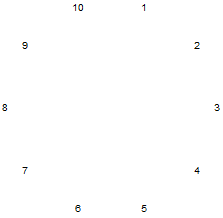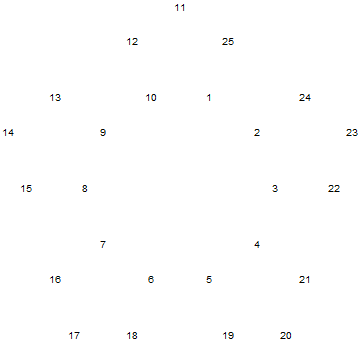For the penta-orchard with 25 trees, you might guess that the central 10 trees made a regular decagon. We can check that, and then add a variable if it doesn't work. First, some line intersection code and a pointset.
lineIntersect[{pointset_, {a_, b_}, {c_, d_}}] := Module[{m, n, kk}, kk = ({m, n} /. Solve[ m pointset[[a]] + (1 - m) pointset[[b]] == n pointset[[c]] + (1 - n) pointset[[d]]][[1]]);kk[[1]] pointset[[a]] + (1 - kk[[1]]) pointset[[b]]]
p = RootReduce[Table[{Sin[Pi (2 n + 1)/10], Cos[Pi (2 n + 1)/10]}, {n, 0, 9}]];
Graphics[MapIndexed[Text[#2[[1]], #1] &, p]]

Then the four points on the left can be calculated.
left = RootReduce[{lineIntersect[{p, {7, 10}, {1, 4}}], lineIntersect[{p, {5, 10}, {1, 2}}], lineIntersect[{p, {1, 10}, {9, 4}}], lineIntersect[{p, {2, 9}, {5, 8}}]}];
Are these all on a line? RootReduce[Det[Append[#, 1] & /@ Take[left, 3]]] gives 0, so yes they are.
new = Join[p, Flatten[Table[RootReduce[RotationMatrix[2 Pi n/5].# & /@ Take[left, 3]], {n, 0,4}], 1]];
Graphics[MapIndexed[Text[#2[[1]], #1] &, new]]

That points the closest trees 0.618034 apart, so just divide by that and multiply by the required distance between trees.
 Attachments:
Attachments: